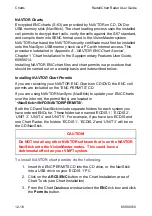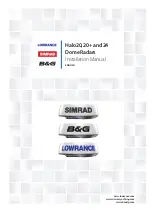
Radar/Chart Radar User Guide
Charts
65900010 12-3
Chart Rendering
The rendering of Chart data adheres to the z-order
36
guidelines, allowing
for radar video to be inserted in the proper z-order such that `suppressed'
chart objects appear below the radar video, and `over radar' chart objects
appear above the radar video.
Factors affecting Chart Accuracy
A position plotted on a navigational chart is only as good as the accuracy of
the chart. Therefore it is important to understand the factors which may limit
the accuracy of vector charts. These factors are detailed below.
Survey Data
Vector charts are generally based on recent hydrographic survey data.
However, the level of detail provided by different types of chart data may
vary greatly depending upon the geographic location; these charts may
sometimes use old survey data where more recent surveys do not exist.
Chart Datum
The chart datum is the mathematical model used by a chart maker to map
the earth’s surface. VisionMaster FT uses the datum known as World
Geodetic System 1984 (WGS-84) Ellipsoid Earth model. Charts and all
chart objects are displayed using the WGS-84 datum whenever possible.
While WGS-84 is the present standard for accurate mapping and display of
position information, there are hundreds of data in use, and each makes
different assumptions about the exact size and shape of the earth. This
means that a given latitude and longitude can correspond to different
locations when plotted on charts that are derived from different data. It is
therefore important to be aware of the datum of the displayed chart.
If a chart is based on another datum, the system offsets the chart to WGS-
84, if the offset to WGS-84 is known and provided in the chart file. Offset
correction values used for the chart are computed as average values for
the entire chart. These correction values may not be perfectly accurate
throughout the geographical area covered by the chart. Datum
discrepancies become more important when using larger-scale charts.
36
The term `Z-order' refers to the order of objects along the Z-axis. In coordinate geometry, X
typically refers to the horizontal axis (left to right), Y to the vertical axis (up and down), and Z
to the axis perpendicular to the other two (forward or backward). One can think of the windows
in a display as a series of planes parallel to the surface of the monitor. The windows are
therefore stacked along the Z-axis, and the Z-order information thus specifies the front-to-back
ordering of the windows on the screen.
Summary of Contents for VisionMaster FT
Page 1: ...Radar Chart Radar User Guide Northrop Grumman Sperry Marine B V Part Number 65900010 ...
Page 2: ......
Page 4: ...Radar Chart Radar User Guide 65900010 ii Intentionally Blank ...
Page 24: ...Overview Radar Chart Radar User Guide 1 2 65900010 Single System ...
Page 42: ......
Page 114: ......
Page 212: ......
Page 304: ......
Page 370: ......
Page 450: ......
Page 462: ......
Page 502: ......
Page 516: ......
Page 532: ......
Page 533: ......
















































